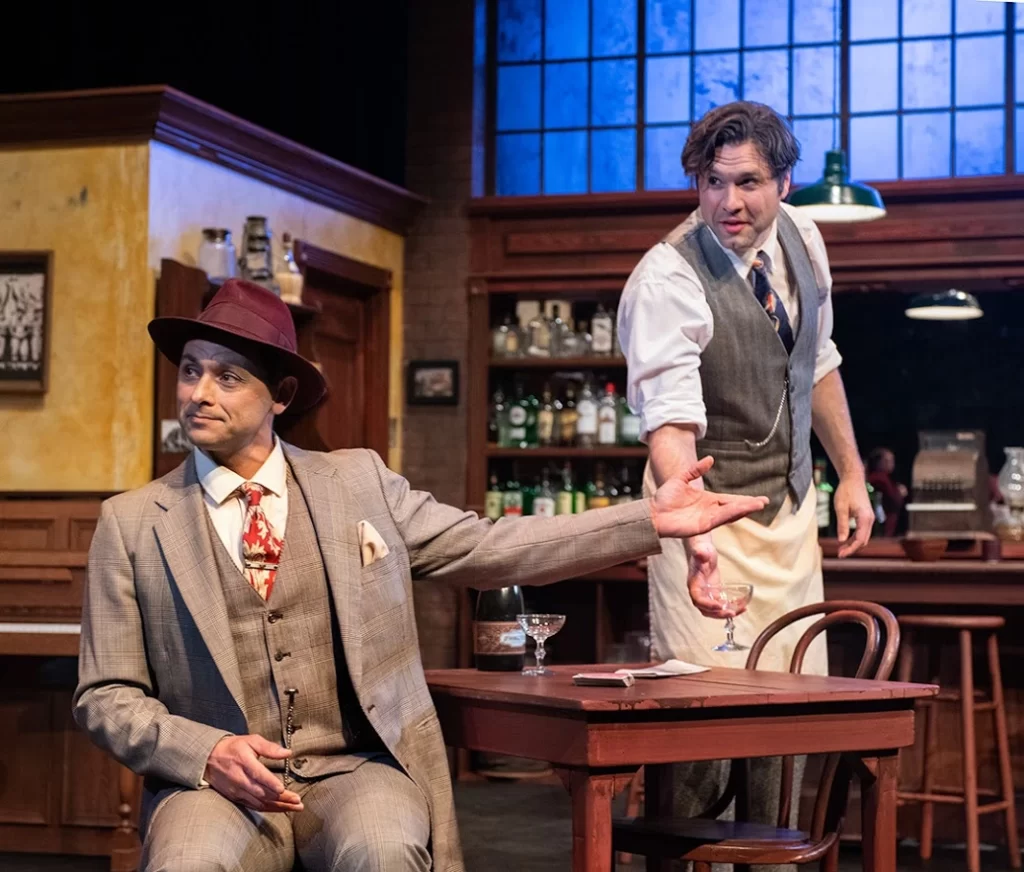Certain American playwrights evoke an era so beautifully that even though those days are long gone, it’s worthwhile to revisit them once in a while.
John Steinbeck did just that when he wrote both the book (and co-wrote the play) “The Grapes of Wrath” about the depression years in the late 1920s and early ’30s.
And William Saroyan’s “The Time of Your Life,” set in a San Francisco bar in 1939, suggests the highs and lows of that period in American history. It runs through Sunday at Cabrillo College’s Black Box Theater in Aptos.
Director Robin Aronson understands this well and smartly designs her concept of the play around Saroyan’s original concept. Maria Crush’s period costumes are a huge addition, except for a few of the 1940s-ish suits which are too baggy on some of the men. But the women’s dresses are uniformly authentic. Even the streetwalkers (the word for prostitutes in that era) wear outfits that are attractive and faithful to the 1930s.
As well, Skip Epperson’s warm, wooded bar with its oft-used tables and chairs, pinball machine, jukebox and well-stocked liquor supply enables audiences to easily believe they’re sitting in Nick’s Pacific Street Saloon, Restaurant and Entertainment Palace, the long moniker than the owner lovingly named it.
It’s helpful to have some understanding of the time and location. Nick’s saloon is near the waterfront, during a time when there’s unrest between the longshoremen (most of whom are out of work), strikebreakers, the ‘working girls’ and the police.
Two cast members create indelible characters in this “Life:” Steven Macramalla as the central character Joe, a mysteriously wealthy man who just sits at a table during most of the play while dispensing wisdom, dollars and generosity to anyone he chooses to befriend. Macramalla is thoroughly convincing as Joe: impassive with a steady gaze, he pronounces that he just wants to live “a civilized life” without hurting anyone.
As Nick, the owner of the saloon, Drew Crocker brings such authenticity to the role, you’d swear he’s been a bartender all his life. Crocker has this ingrained look of believability, even when he’s rolling his eyes at some of the goings-on in his establishment.
A whole menagerie of people drop in and out of the bar (and the play), sometimes never returning again. But some stick to Nick like glue. Karen Blagmon is memorable as Lesley, a malnourished woman who stumbles in and asks for some food. Nick never turns away anyone, especially someone who looks like she needs food as much as Lesley does. He tells her to go in the kitchen, get something to eat, and come back to the bar where he’ll find some chores for her to do. But after eating, she sits down at the piano and starts playing….and playing…and playing. Youza! Those honky-tonk songs never sounded so good.
Nick always seems genuinely amazed at the eccentricities of the people who meander into his bar. Take Harry (tall, lean Liam Kuhn), who fancies himself a comedian and dancer. Nick tells Harry to get up on stage and try out his comedy routine. Turns out Harry is the only person who thinks Harry’s material is funny, but he’s a pretty good dancer, so Nick tells him to stick around and practice his dancing….which he does for the rest of the play.
These are just a few of the characters who people Saroyan’s play. There are 26, so don’t try to keep track of them all. Some are only on for 15-20 seconds and never return. Others, like dark-eyed, mysterious Arab (an affecting Nora Sarkissian) says nothing for all of Act One. Instead, she sits at the bar, reads the paper, and stares at the other people in the bar. But in Act Two, she suddenly starts talking nonstop, then pulls out a harmonica and begins to play softly.
Maxwell Bjork makes an appealing Dudley, so hungry for love that when he misdials his girlfriend’s phone number, he invites the female who answers to meet him at the bar. She does, but she’s not what he expects so he becomes discombobulated and insists he’s not Dudley. Mostly, he just hangs around the bar and moons over Elsie, his girlfriend, who finally shows up at Nick’s toward play’s end
Steven Capasso as the hard-drinking, gun-swinging Kit Carson and Devon Beale as the unhappy prostitute Kitty also make strong impressions in their roles.
Just don’t try to make sense of most of what’s going on onstage. It’s impossible to do because Saroyan’s critically acclaimed play (it was the first to ever win a Pulitzer Prize for Drama after it opened on Broadway in 1939) is intended more to show that even a bar can be a safe haven from the hostile world on the other side of the doors.
No matter what they’re escaping from, Nick’s patrons mostly encounter acceptance, sometimes friendship, generosity (from Joe and Nick) and goodwill. In other words: It’s a place where it’s OK to dream, to get sustenance (both food and friendship), to escape from being lonely and, sometimes even to find love….and hope.
Sounds like a place everyone needs when life gets too lonely and harsh.
This article was originally published by Joanne Engelhardt of the Santa Cruz Sentinel and can be found here:

